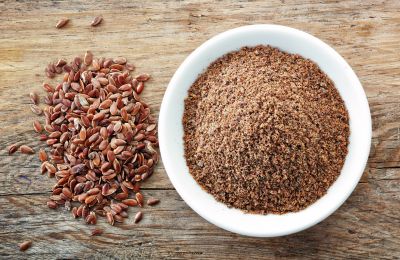ORGANIC Flaxseed oil
virgin



EU- / non EU agriculture

- 8-week mill freshness guarantee
- rich in omega-3 fatty acids
- mild, nutty taste
- cold-pressed fresh from the mill every day
- vegan, gluten- and lactose-free
- only 2 teaspoons (3 g each) per day
from 31388 ratings





Our mill-fresh, cold-pressed organic linseed oil has a shelf life of eight weeks after production. Linseed oil, also known as linseed oil, is obtained from the ripe seeds of the flax plant. Our virgin organic linseed oil is a healthy and natural edible oil that is cold-pressed fresh from the mill every day in our oil mill and then gently filtered. Apart from the linseed plant, hardly any other plant contains such large quantities of the valuable omega-3 fatty acid alpha-linolenic acid. Correct storage ensures the quality of this valuable vital oil. Please always keep our organic linseed oil well sealed and in the refrigerator.
Linseed oil - rich in omega-3
Linseed oil is characterized by a particularly high content of alpha-linolenic acid, which makes up more than half of the fatty acids in the oil. Alpha-linolenic acid is a plant-based omega-3 fatty acid that is considered an essential fatty acid for the body's metabolism.
As it also contains little linoleic acid (an omega-6 fatty acid), flaxseed oil is very well suited to shifting the ratio of omega-6 to omega-3 fatty acids in the diet towards omega-3. This has been recommended by nutritional science for years because today's diet contains too many omega-6 fatty acids. For this reason, more omega-3 fats should be consumed regularly.
The European Food Safety Authority (EFSA) has already approved the following health claims for ALA in the Health Claims Regulation: ALA contributes to the maintenance of normal blood cholesterol levels. Just 2 teaspoons (3 g each) cover the daily requirement of 2 g ALA for an adult. Make sure you eat a varied and balanced diet and lead a healthy lifestyle.
Valuable oil from linseed
 Linseed unprocessed and ground
Linseed unprocessed and groundLinseeds are the small, brown seeds of the blue-flowering flax plant. They are surrounded by a firm shell that ideally protects the inside of the seed and contain around 40g of fat per 100g. They also contain around 20 g of fiber and 20 g of protein per 100 g.
The flax plant, also known as flax, is one of the oldest cultivated plants in the world and was mainly used as a raw material for textiles in the past. Linseed, as well as the linseed oil obtained from it, was already considered a remedy for many different diseases and ailments in ancient Greece.
Today, linseed is known as a superfood and is a popular ingredient in bread and muesli. At Ölmühle Solling, we have been producing our mill-fresh linseed oil from linseed since 1996. This is one of the vegetable oils with the highest content of alpha-linolenic acid (approx. 50 g per 100 g).
The balance between omega-3 and omega-6 fatty acids
 Photo: Dana Lohmüller
Photo: Dana LohmüllerThe special thing about linseed oil is its high content of alpha-linolenic acid, an essential omega-3 fatty acid. Over the last century, dietary habits in Western countries, including Germany, have changed considerably. The ratio of omega-6 to omega-3 fatty acids in the diet has shifted from the originally recommended balance of 3:1 to almost 20:1. This is partly due to the regular consumption of ready meals, fast food and an unbalanced diet. The food industry often uses refined cooking oils and fats in the production of food. Margarine and hydrogenated fats, which are made from sunflower oil, for example, are used in preparation and lead to an increase in omega-6 fatty acids in the body in the long term.
However, a correct balance between the two fatty acids has a decisive influence on the function and metabolism of the cells in the human body. Omega-6 fatty acids are said to promote inflammation and omega-3 fatty acids to have an anti-inflammatory effect in the body.
Both modes of action are essential for the body, but the right ratio is important for sustainable health. Both linseed and linseed oil are ideal for restoring the balance between omega-6 and omega-3 fatty acids.
Why our linseed oil does not taste bitter
Many people associate linseed oil primarily with a bitter taste. This is mainly due to the fact that linseed oil is very sensitive compared to other edible oils due to its special fatty acid spectrum and often tastes rancid by the time it is consumed. Linseed oil contains more than 50 g of alpha-linolenic acid per 100 g. Alpha-linolenic acid, or ALA for short, is an essential omega-3 fatty acid, more precisely a triple unsaturated fatty acid with 18 carbon atoms. The high amount of triple unsaturated fatty acids causes the oil to oxidize quickly, which means that it can quickly become rancid and take on a bitter taste if produced and stored incorrectly.
Mill-fresh cold pressing for the best quality
We produce our linseed oil daily in our factory. It only takes a few minutes for the drop of oil to reach the light-protected barrel. Virtually no oxidation takes place within this short period of time. On its way into the light-protected glass bottle, the suspended matter in the linseed oil is filtered out. Each bottle is fitted with a spring dosing device when it is closed, which enables easy and accurate dosing. In addition to easy dosing, this has a further advantage: there is less oxygen contact than with a large bottle opening, which protects the linseed oil from rapid oxidation. Our linseed oil is always stored in a cool, dark place until it is shipped.
After calptressing, we give our organic linseed oil a minimum shelf life of eight to ten weeks, thus following our quality standards of producing absolutely natural and high-quality products from high-quality raw materials. The taste of linseed oil not only determines its enjoyment, but is also an indication of good quality. Because fresh, high-quality linseed oil can be recognized above all by its mild, non-bitter taste. We believe that the value of our organic products is not determined by their shelf life, but by their taste.
The flax plant

The flax plant, also known as flax, is one of the oldest cultivated plants in the world and has been grown for thousands of years. Flax is an annual plant recognizable by its blue flowers. Traditionally, it has also played a prominent role in our culture, as can be seen from the fact that many expressions related to flax or flax processing have found their way into everyday language: Whether we are merrily flapping about, losing the plot, taking a trip into the blue, getting our wires crossed, rushing someone through or making something look shabby, the origin of all these terms lies in the laborious processing of the stalks of flax into linen.
Flax has also been highly valued for thousands of years for its edible seeds: They provide the body with essential fatty acids and fiber. In the past, almost every village had its own oil mill and traders would roam the streets selling fresh oil. However, as the oil is particularly sensitive to heat and light, it lost its importance in the course of industrialization: linseed oil is too perishable for large-scale production and it was not durable enough to be traded over long distances. For this reason, we press the precious oil in our oil mill daily from organic linseed and always in small batches fresh from the mill.
Use of linseed oil
Our mill-fresh, virgin organic linseed oil can be used in a variety of ways. However, due to its sensitivity to oxidation, it should only be used for cold dishes and should not be used for frying. It can only be used for short steaming.
- as an ingredient in salad dressings
- for breakfast muesli
- for dips and sauces
- for smoothies and shakes
- for skin care
- for oil pulling
- pure on the spoon
- For wood care
If your linseed oil is past its best-before date and loses its mild, pleasant taste, you do not have to dispose of the oil. It is perfect for maintaining untreated natural wood. Apply a thin layer of linseed oil to the wood with a brush and leave to soak in for at least 24 hours.
Quality decides

Good and fresh organic linseed oil can be recognized above all by its mild, non-bitter taste. Of course, the quality of the raw material is crucial for the quality of the oil. We prefer to work with organic farmers from our region - Sebastian Baensch, Managing Director of Ölmühle Solling, and organic farmer Henning Niemann from Uetze, can be seen in the photo in the flowering linseed field during quality control.
Unfortunately, this regional cultivation is not always possible: the cold snap in spring and the rainy summer in Germany have not been without consequences for the linseed harvest. The long, dry summer in turn had an impact on the quality of the linseed. This year, we are again processing Naturland-certified organic linseed from various growing regions in Europe and overseas, which are of perfect sensory and analytical quality.
Freeze linseed oil for a longer shelf life
Ideally, you should always consume freshly pressed linseed oil, but if you don't manage to use the oil within the recommended 8-12 weeks, you can freeze it. When frozen, the oil lies dormant, so to speak. The glass bottles will not burst as oil, unlike water, contracts when cold. As soon as the oil is thawed again, it regains its physical and chemical properties. Please only defrost the oil in the refrigerator. During deep-freeze storage, chemical reactions (such as oxidation with atmospheric oxygen) are extremely slowed down, so that the shelf life of the organic linseed oil is extended (in our experience up to half a year).
Linseed oil and camelina oil - often confused and yet different

Often confused and yet completely different: flax and camelina are completely different plants. While the flax plant belongs to the flax family, camelina belongs to the cruciferous family, just like the rapeseed or mustard plant.
Both the seeds of the flax plant and the seeds of the camelina plant contain high amounts of the polyunsaturated alpha-linolenic acid, also known as omega-3 fatty acid. The proportion of this essential fatty acid in linseed oil is around 50 g per 100 g, while camelina oil contains around 41 g of omega-3 fatty acid per 100 g. The taste of our linseed oil is nutty and mild, while camelina oil has a pea and hay-like flavor.
This fresh taste makes camelina oil ideal in combination with all kinds of vegetables. It is therefore an ideal oil for salads and steamed vegetables. Like linseed oil, camelina oil goes perfectly with quark and jacket potatoes. Due to its high omega-3 content, we recommend not heating the oil too much, but only using it for steaming in hot dishes.
Leash cakes for dogs and horses

Incidentally, the press cake that is produced when processing organic linseed into linseed oil is a high-quality supplementary feed for horses and dogs, as the essential fatty acids in the linseed cake can have a positive effect on metabolic processes and coat metabolism in the event of feed-related deficiencies.
Regular feeding can also ensure a shiny coat. . Linseed cake can also strengthen the animal's immune system. In addition, the high mucilage content stimulates intestinal activity and can help prevent colic.
In veterinary medicine, linseed cake is used for its digestive and anti-inflammatory effects, among other things.
This cold pressing at temperatures below 40 °C preserves the valuable ingredients in their best form. Just like our linseed oil, the press cake is naturally free from additives and contains valuable unsaturated fatty acids, in particular omega-3 fatty acids and lignans. The press cake still contains around 10 percent of the valuable linseed oil. In addition, the crude protein content of linseed cake is around 36 g per 100 g. Linseed cake is high in calories and is therefore also an ideal supplementary feed for heavy-fed horses and dogs.
Usage
Virgin organic linseed oil should only be used cold due to its sensitivity to oxidation. It is suitable for dressings, marinades and dips and enriches breakfast muesli, smoothies and yogurt.
A traditional specialty from Silesia is boiled potatoes with linseed oil and quark. Of course, linseed oil can also be enjoyed pure on the spoon. Please always keep it well sealed and in the fridge. The oil will keep there for about 8 weeks. Linseed oil can also be frozen to extend its shelf life and can then be kept for up to six months. Linseed oil is not suitable for frying.
Recipe

Smoothies with flaxseed oil
Recipe for smoothies with flaxseed oil. Garnish according to taste with unsweetened yogurt, half a banana, apple slices or granola. zum Rezept
Turmeric ginger shot
Easy recipe for a ginger shot with turmeric powder. Rounded off with freshly squeezed orange and lemon juice, mill-fresh flaxseed oil and agave syrup. zum Rezept
Breakfast bowl
Recipe for a breakfast bowl with flaxseed oil. Garnished with granola, chia seeds and fresh fruits and berries. Also tasty with other fruits like kiwis, blueberries, peach or pineapple. zum RezeptOverview of linseed oil recipes
Ratings
Specification and ingredients
Flaxseed oil
Average energy and nutrient content for 100 g
Please enjoy our products as part of a diverse and balanced nutrition.
As a product of nature the composition of the oil can vary, the given specifications are therefore average values.
Ingredients
Linseed oil, certified organicDurability
7-8 weeksLagerung
Store in a cool and dark place. Especially after opening, we recommend to store the oil in the refrigerator.Fatty acids diagram

| Chemical-physical parameters Acid value: 4 mg KOH/g FfA: < 2 mg KOH/g Peroxide value: < 10 mEq O2/kg Iodine value: 170-204 Saponification value: 188-196 Density 20°C: 0.930-0.936 g/cm3 |
Sensory properties Consistency: Linseed oil is liquid at room temperature Appearance: yellow to dark yellow oil Odor: characteristic, neutral Taste: tart, neutral, nutty, mild, tart |
You can also find more information on linseed oil at leinoel.bio.






 Hemp seed oil
Hemp seed oil Flaxseed flour
Flaxseed flour Camelina oil
Camelina oil

Sehr geehrter Herr Krüger,
leider haben Sie Ihr Leinöl nicht in der von Ihnen gewohnten Qualität erhalten. In diesem Fall können Sie sich einfach schriftlich oder telefonisch mit uns in Verbindung setzen, so dass wir die Möglichkeit haben, die ausgelieferte Charge in unserer Abteilung für Qualitätssicherung zu prüfen.
Kosten entstehen Ihnen hierbei keine.
Nach unserem freundlichen Telefonat heute befindet sich das Öl jetzt in Prüfung.